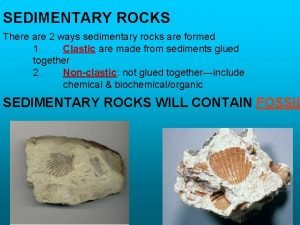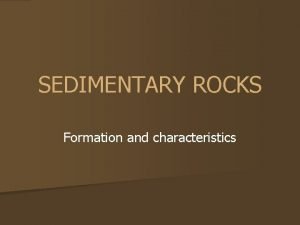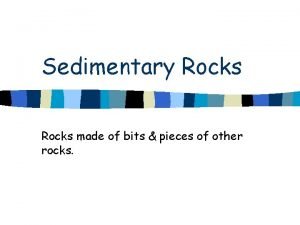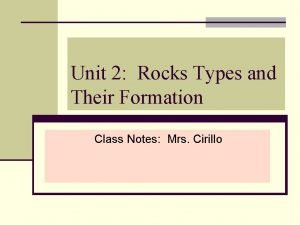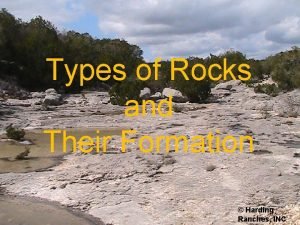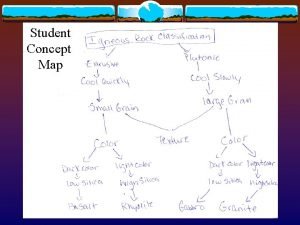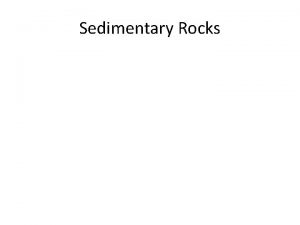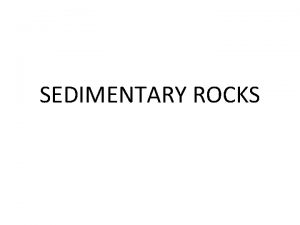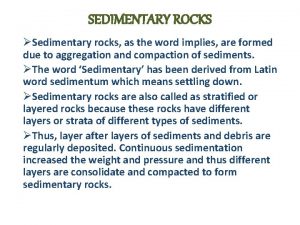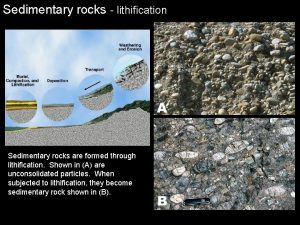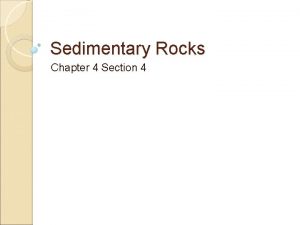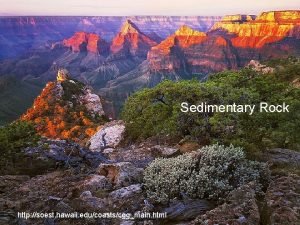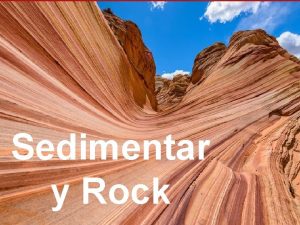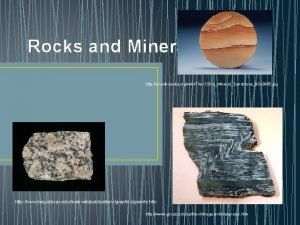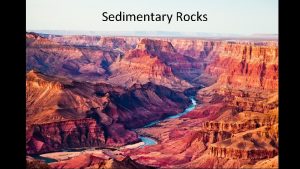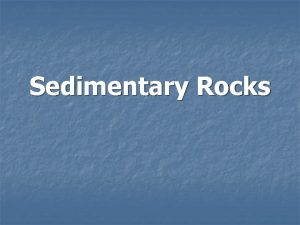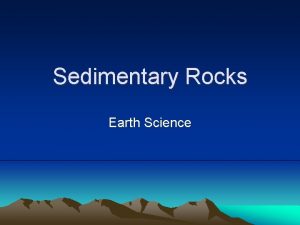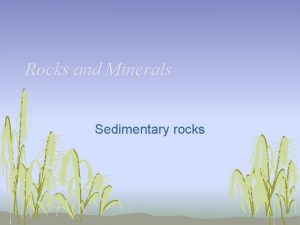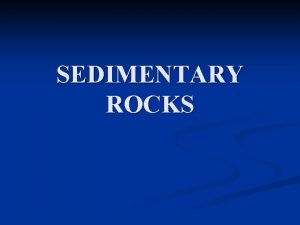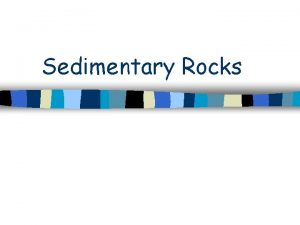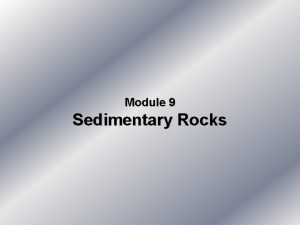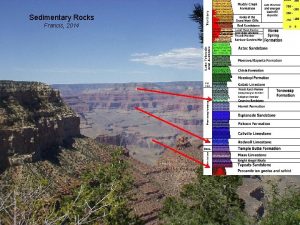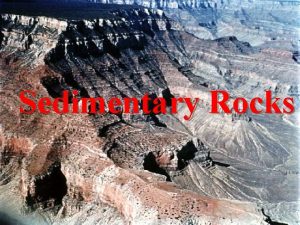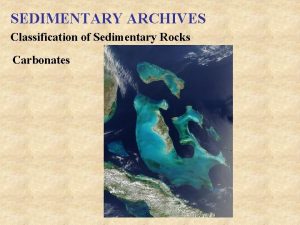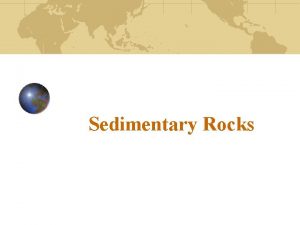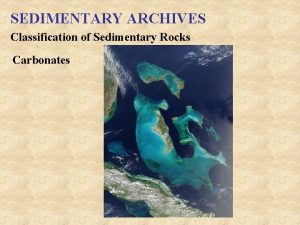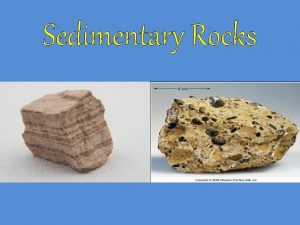SEDIMENTARY ROCKS Rocks can form from particles Sediments






















- Slides: 22

SEDIMENTARY ROCKS

Rocks can form from particles Sediments- are materials that settle out of water or air. Loose materials of rocks and minerals Pieces of plant and animal remains

Sedimentary rocks Develop from layers of sediment that build up on land or underwater This sediment comes from weathering (chemical or physical) It collects and forms layers Deposition is when sediments are laid down on the ground or sink to the bottoms of bodies of water

Layers of sedimentary rock These layers can get pressed together by the PRESSURE from the upper layers Lithification- the physical and chemical processes that transport sediments into sedimentary rocks---this begins with compaction

Layers of sedimentary rock Sediment can also be held together by minerals that have crystallized between them, acting as a cement Cementation- when mineral growth cements sediments together into solid rock can either occur when a new mineral grows between the grains OR the same mineral grows between and over the grains in a process called overgrowth.

Examples of sedimentary rocks Limestone(coral reefs), coal, gypsum

Limestone is made of carbonate minerals

Coral reefs consist of limestone that comes from organisms

Coal is made up of dead plants

Conglomerate consists of individual stones that have become cemented together

Shale is the most common sedimentary rock and was once clay minerals

Features of Sedimentary Rocks The primary feature of sedimentary rocks is horizontal layering, called bedding.

Graded Bedding in which the particle sizes become progressively heavier and coarser towards the bottom layers. Often seen in marine sedimentary rocks

Cross-Bedding Formed as inclined layers of sediment move forward across a HORIZONTAL surface. Can be observed at sandy beaches, along sandbars and dunes.

Fossils Best known feature of sedimentary rocks During lithification, parts of the organism can be replaced minerals and turned into rock (like fossilized shells).

Clastic Sedimentary Rocks Most common type of sedimentary rocks Formed from deposits of loose sediments Classified by the size of their particles Coarse-grained Medium-grained Fine-grained

Coarse-grained Clastics Sedimentary rocks consisting of gravel-sized rock and mineral fragments Conglomerates and Breccias----both coarse grained but rounded edges in conglomerate indicate it had a long transport distance and was weathered and rounded

Medium-Grained Clastics Medium-grained clastics- contain sandsized rock and mineral fragments Example: Sandstone-can be used to map old stream and river channels Porosity- percentage of open spaces between grains in a rock

Fine-grained clastics Fine-grained clastics- sedimentary rocks that contain silt and clay sized sediments and mud (siltstone and mudstone) Example: Shale---LOW porosity

Chemical Sedimentary Rocks Formed From Evaporation When concentrations of dissolved minerals reaches saturation (the point at which no more minerals can be dissolved in the water), crystal grains precipitate out of solution and settle at the bottom. The layers of sedimentary rocks that from as a result of his are called evaporites.

Most Common Evaporite Minerals Calcite (Ca. CO 3), Halite (Na. Cl) and Gypsum (Ca. SO 4)

Organic Sedimentary Rocks Formed from the remains of once-living things Examples: Limestone (mostly calcite), coral, limestone (from shells etc. ), coal Sedimentary rocks provide geologist with information about surface conditions that existed in Earth’s past
 Can igneous rocks form metamorphic rocks
Can igneous rocks form metamorphic rocks Igneous metamorphic sedimentary
Igneous metamorphic sedimentary Shale clastic or non clastic
Shale clastic or non clastic Characteristics of sedimentary rocks
Characteristics of sedimentary rocks How is chemical sedimentary rock formed
How is chemical sedimentary rock formed Sedimentary weathering
Sedimentary weathering Esrt sedimentary rocks
Esrt sedimentary rocks Sedimentary rocks examples
Sedimentary rocks examples Concept map for igneous rocks
Concept map for igneous rocks Siliceous rocks examples
Siliceous rocks examples Detrital sedimentary rocks
Detrital sedimentary rocks Define bioclastic
Define bioclastic Characteristics of sedimentary rocks
Characteristics of sedimentary rocks What are sedimentary rocks
What are sedimentary rocks In sedimentary rocks lithification includes
In sedimentary rocks lithification includes Sedimentary rocks
Sedimentary rocks Sorting sedimentary rocks
Sorting sedimentary rocks Sedimentary rocks examples
Sedimentary rocks examples Erosion hawaii
Erosion hawaii Facts on sedimentary rocks
Facts on sedimentary rocks Metamorphic rocks properties
Metamorphic rocks properties How could you tell
How could you tell Classify sedimentary rocks
Classify sedimentary rocks


